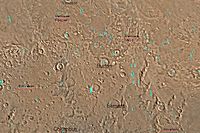- Columbus (crater)
-
Columbus Crater
Map of Memnonia quadrangle labeled with major features.Planet Mars Coordinates 29°48′S 166°06′W / 29.8°S 166.1°WCoordinates: 29°48′S 166°06′W / 29.8°S 166.1°W Diameter 119 km Eponym Christopher Columbus, Italian explorer (1451-1506) Columbus Crater is a crater in the Memnonia quadrangle of Mars, located at 29.8° south latitude and 166.1° west longitude. It is 119 km in diameter and was named after Christopher Columbus, Italian explorer (1451–1506).[1]
Layers
Columbus Crater contains layers, also called strata. Many places on Mars show rocks arranged in layers. Sometimes the layers are of different colors. Light-toned rocks on Mars have been associated with hydrated minerals like sulfates. The Mars Rover Opportunity examined such layers close-up with several instruments. Some layers are probably made up of fine particles because they seem to break up into fine dust. Other layers break up into large boulders so they are probably much harder. Basalt, a volcanic rock, is thought to be in the layers that form boulders. Basalt has been identified on Mars in many places. Instruments on orbiting spacecraft have detected clay (also called phyllosilicates) in some layers. The CRISM instrument on the Mars Reconnaissance Orbiter found kaolinite, hydrated sulfates including alunite and possibly jarosite.[2] Scientists are excited about finding hydrated minerals such as sulfates and clays on Mars because they are usually formed in the presence of water.[3] Places that contain clays and/or other hydrated minerals would be good places to look for evidence of life.[4] Recent research with an orbiting near-infrared spectrometer, which reveals the types of minerals present based on the wavelengths of light they absorb, found evidence of layers of both clay and sulfates in Columbus crater. This is exactly what would appear if a large lake had slowly evaporated. Moreover, because some layers contained gypsum, a sulfate which forms in relatively fresh water, life could have formed in the crater.[5]
Rock can form layers in a variety of ways. Layers may be formed by volcanoes, wind, or water.[6]
-
Columbus Crater Layers, as seen by HiRISE. This false-color image is about 800 feet across. Some of the layers contain hydrated minerals.
References
- ^ http://planetarynames.wr.usgs.gov
- ^ Murchie, S. et al. 2009. A synthesis of Martian aqueous mineralogy after 1 Mars year of observations from the Mars Reconnaissance Orbiter. Journal of Geophysical Research: 114.
- ^ http://themis.asu.edu/features/nilosyrtis
- ^ http://hirise.lpl.arizona.edu/PSP_004046_2080
- ^ http://news.nationalgeographic.com/news/2009/11/091125-mars-crater-lake-michigan-water_2.html
- ^ http://hirise.lpl.arizona.edu?PSP_008437_1750
Categories:- Memnonia quadrangle
- Impact craters on Mars
- Astrogeology stubs
- Mars stubs
-
Wikimedia Foundation. 2010.



